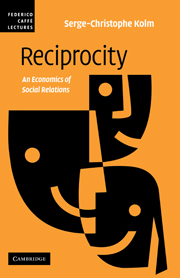Book contents
- Frontmatter
- Contents
- List of illustrations
- Foreword
- Introduction
- Part I Facts and forms
- Part II Motives
- Part III Values and reasons
- Part IV The economics of reciprocity
- 17 General methodology of reciprocity analysis
- 18 The theory of comparative, matching, or balance reciprocity
- 19 The theory of liking reciprocity
- 20 Strategic interaction and process preferences: games of reciprocity
- 21 General properties of processes
- 22 Solutions of reciprocity games; comparisons
- 23 Reciprocity in the understanding of society and its economy
- Bibliography
- Index
17 - General methodology of reciprocity analysis
Published online by Cambridge University Press: 22 September 2009
- Frontmatter
- Contents
- List of illustrations
- Foreword
- Introduction
- Part I Facts and forms
- Part II Motives
- Part III Values and reasons
- Part IV The economics of reciprocity
- 17 General methodology of reciprocity analysis
- 18 The theory of comparative, matching, or balance reciprocity
- 19 The theory of liking reciprocity
- 20 Strategic interaction and process preferences: games of reciprocity
- 21 General properties of processes
- 22 Solutions of reciprocity games; comparisons
- 23 Reciprocity in the understanding of society and its economy
- Bibliography
- Index
Summary
The previous analysis of reciprocity should be continued by a formal analysis. This permits making the relations in question more precise and finding out the consequences of sets of relations, in particular the consequences of the interdependence among the acts, sentiments and attitudes of agents that concern others.
In the end, we will arrive at the discussion of the form most classic in economic analysis. In this form, there are two individuals indexed by i and j, who, respectively, chose items xi and xj and seek the highest value of ordinal utility functions ui (xi, xj, zi) and uj (xj, xi, zj), where zi and zj denote sets of relevant parameters (they can in particular include a description of the type of relationship between these two individuals when they make these choices). These utility functions can be generalized into preference orderings, which is practically relevant when some aspects of the choices have priority. The resulting interaction also depends on other items, besides domains of choice, such as the information of agents, the order of actions in time, and possibilities of communication and agreement.
In such a formulation, xi or xj can, for instance, be a gift of any kind, and the other the return gift (or a harm and the corresponding response).
- Type
- Chapter
- Information
- ReciprocityAn Economics of Social Relations, pp. 245 - 250Publisher: Cambridge University PressPrint publication year: 2008

